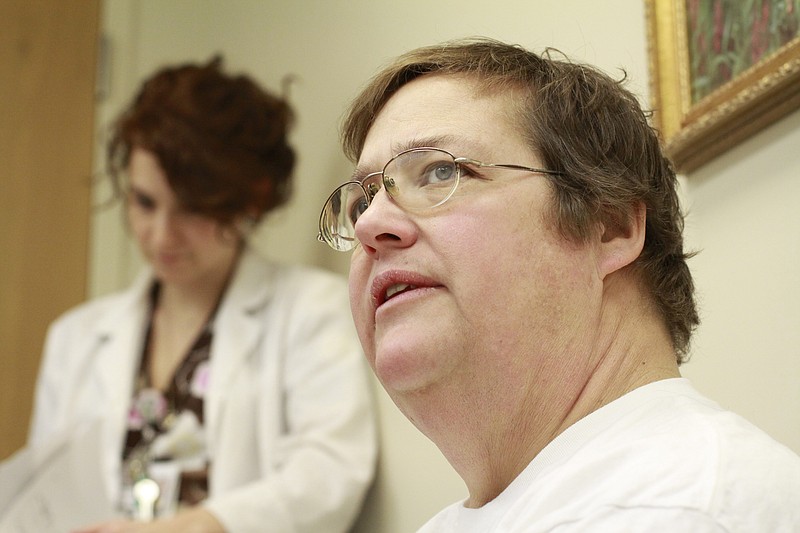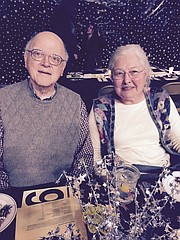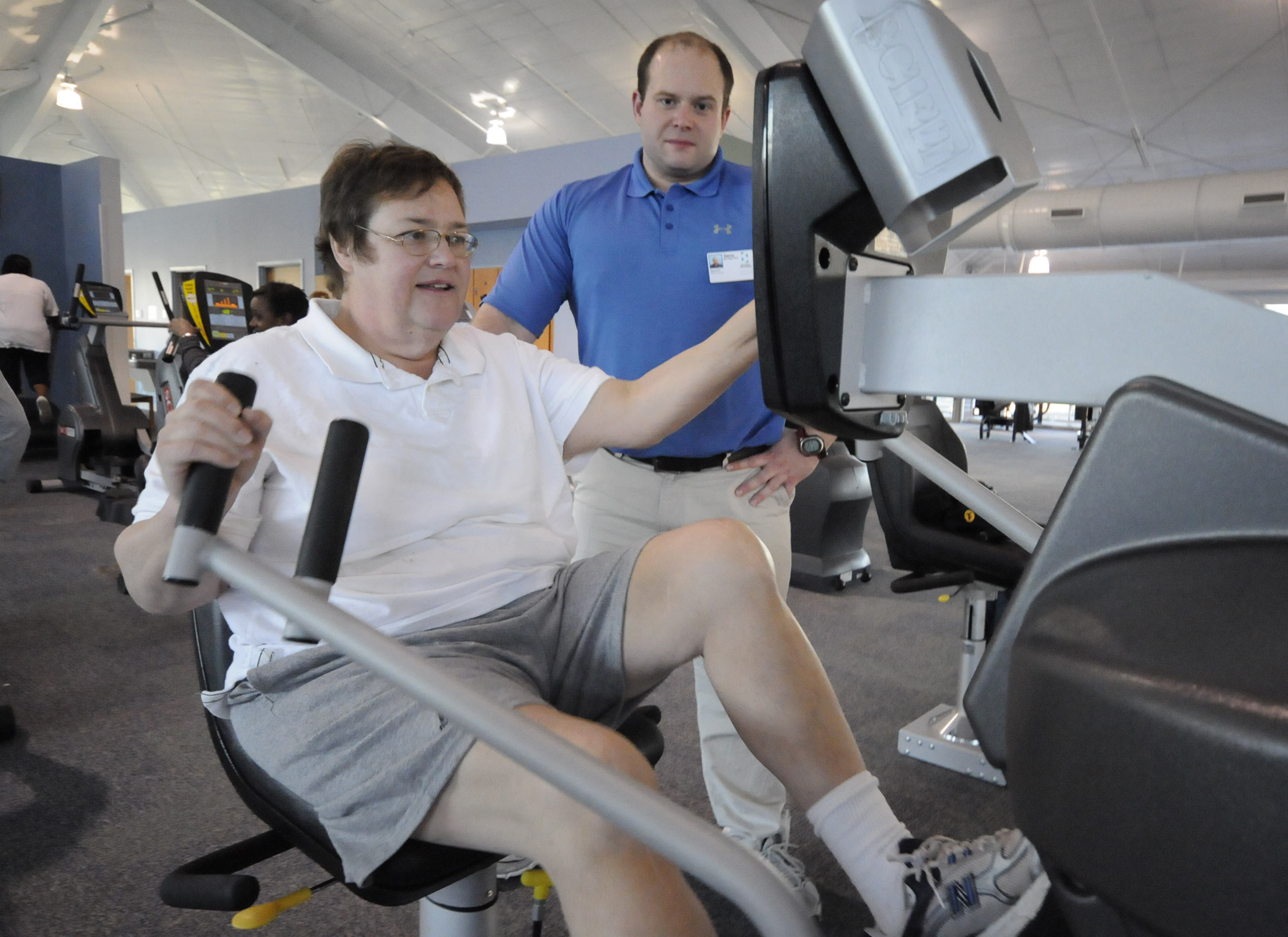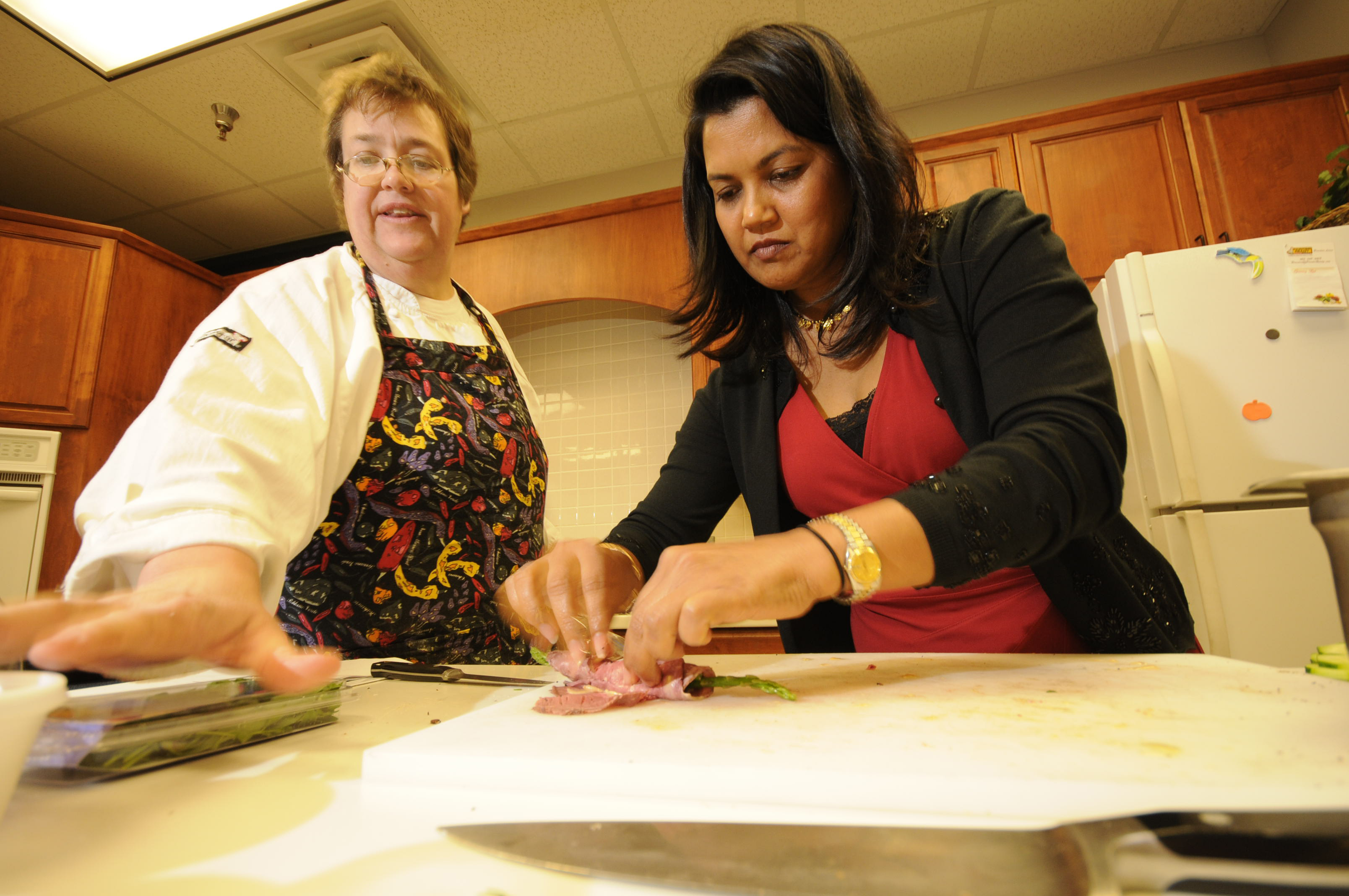This is not another poor little fat girl story. In fact, Virginia Cofer liked being big.
"I'm a big person, a loud person," says the Chattanooga restaurateur. "I like taking up space. I always said my weight kept me grounded."
But what was keeping her grounded was also threatening to kill her.
She had gotten used to not being able to cross her legs. She never minded wearing men's clothing. She wasn't concerned about the way she looked.
She was concerned about her health. And so were her doctors.
Cofer weighed more than 350 pounds. She had developed weight-related diabetes, sleep apnea and narrowing of the spinal column known as stenosis. She'd had a stroke. At times, she could barely walk.
By 2008, Cofer knew she needed to make a change. Otherwise, she was on the road to becoming one of the approximately 112,000 Americans who die each year of obesity-related causes.
She let two more years pass without taking action.
Then came the crisis that made her realize she was a "walking time bomb."
Counting the cost
COFER'S ROAD TO HEALTHHeaviest weight: 369 poundsPresurgery weight: 352 pounds3-month checkup: 270 pounds6-month checkup: 246 pounds9-month checkup: 226 pounds1 year: No weight recorded2 years: 234 pounds
She had tried the usual methods -- diet and exercise. She can't remember how many times she did Weight Watchers and Jenny Craig. Even being asked the question is irritating.
"That's like asking an addict how many times did they have a beer," she says.
In 2008, her doctor recommended gastric sleeve surgery -- an operation that reduces the stomach to the size of a banana, and changes its metabolic and hormonal function.
"The sleeve gastrectomy changes the biology that gives people a chance to lose weight that they couldn't otherwise," said Dr. Jack Rutledge, bariatric surgeon at Memorial Weight Management Center.
The surgery removes the upper, outer portion of the stomach, the portion that produces the hunger hormone ghrelin. Reducing ghrelin production limits the desire to eat.
Eating was Cofer's love, her livelihood. Gastric sleeve surgery would force her to change her entire relationship with food.
There was a risk that she wouldn't be able to taste food the same way, wouldn't be able to tell whether the fish tacos and smoked pork butt sandwiches she sells out of a cheerfully painted Airstream trailer, Petunia's Silver Jalapeno, were right.
The surgery could cost Cofer her career. Doing nothing could cost her life.
Growing up
Food was always a big part of the Cofer household when Virginia was a child. Her mother, a talented cook, would have open-door parties known in the family as "y'all comes."
"My dad would say, 'Mom's doing a y'all come,'" Cofer said.
Virginia, the youngest of four children, loved being in the kitchen with her mother.
She was athletic, too. She played three varsity sports in high school. She had always been large, but then she blew out her knees playing rugby. She stopped playing sports but kept on eating.
That's when the weight gain really started.
Working in restaurants through adulthood, she says, she was often too busy to eat during the day and then would gorge at night. The pounds kept piling on. By 42, she had reached her peak weight, carrying 369 pounds on her 5-foot, 9-inch frame.
According to obesity guidelines developed by the National Heart, Blood and Lung Institute, a 5-foot-9 person who weighs 176 pounds or more is considered to be overweight.
For four more years, the weight stayed. The pain of carrying it increased. The clock ticked away.
Plenty of people lose weight not only for health, but for beauty. The stories of the teen teased for being overweight, the woman who was ashamed to look in the mirror. Then there are the post-weight-loss photos -- self-assured, happy and smiling, perhaps in a bikini or body-skimming dress.
That was never Cofer's goal. She is self-assured, happy and smiling, with a strong sense of humor and a low tolerance for nonsense. She had no interest in a taut, toned stomach. She just wanted to be healthy.
Gastric sleeve surgery is grueling. So is the aftermath. It requires a complete lifestyle change. But by 2008, a lifestyle change had become necessary.
Cofer, who hates to sit still, was in so much pain she couldn't move. For two weeks she was bedridden. Every breath was agony.
"My body literally gave out," she said.
In 2009, she still weighed more than 350 pounds. At one point her pain forced her to the emergency room. She was sent home but saw her doctor the next day, and he ordered her hospitalized. She hurt everywhere from the neck down and needed an epidural just to ease the pain enough to walk.
"That was the final straw that broke the camel's back," she said.
Cofer had first considered surgery in 2008, but decided against it because she feared how it might affect her work. She worried about food tolerance, about her sense of taste, how her relationship with food would be affected.
"You're basically learning to eat all over again," said Kathy Freeman, bariatric surgery coordinator at Erlanger Health System. "The only difference is you know what things have tasted like before."
The idea of surgery was terrifying, but Cofer had to find a way to reclaim her life.
"As unhealthy as I was, I was a walking time bomb," she said. "When you realize you have to have help, it's the biggest relief knowing there is a light at the end of the tunnel."
The decision was made: She would have the operation.
A life-changing cut
RELATED STORYWhat is gastric sleeve surgery?
Even before the surgery could be performed, Cofer had to lose 18 pounds so the surgeon would have room to perform the operation.
But once she achieved that first step, surgery was a go. She was nervous: Would the recovery be painful? How hard will her life be from now on? Will she still be able to taste food the same way? How will she feel? Will she be able to have the discipline she needs? If she loses the weight, will she lose her grounding? Will everything be different?
But in the end, the questions didn't matter. She needed a solution.
The morning of April 19, 2010, Cofer lay on an operating table at Erlanger hospital. Her abdomen was scrubbed for surgery. Rutledge passed a scalpel over her belly. A blunt needle was passed into the small incision and air was injected into the abdomen, blowing it up to create a dome.
Next, Rutledge inserted a trocar -- a surgical tube about the size of a man's middle finger -- and through that, a small laparoscopic camera that allowed him to see everything on a video screen.
He made five more incisions on her abdomen and inserted trocars in each.
The stomach is a large organ. Full, it's about the size of an inflated football. Empty, it's a flat crescent, connecting the esophagus to the duodenum, the upper portion of the small intestine.
In the surgery, a tube is passed down the esophagus. The doctor staples across the stomach alongside the tube, six rows in all, before removing a portion of the stomach through a bag that has been passed through a trocar.
The solid tube remains inside, helping to maintain the shape of the remaining stomach, which now is shaped like a sleeve. As in sleeve gastrectomy. Or gastric sleeve surgery.
Three days later, Cofer went home. It would be three weeks before she could eat solid foods or know whether her sense of taste was altered by the surgery. Three weeks before she would know whether the operation that will help save her life might just end her career.
Making progress
By summer 2010, Cofer had gone from 3,000 calories a day to fewer than 1,000. Tiny servings of food replaced heaping platefuls and even those minuscule amounts, smaller than her hand, were hard to swallow. Or keep down.
Nausea can be a common side effect of gastric surgery because of the hormonal changes to the body. It can also lead to food fear. There is a difference, Rutledge explained, between food fear and simply not wanting to throw up.
Cofer didn't want to be afraid to eat.
At her three-month checkup, the doctor told her to work on eating meals: 6 ounces of food over a 30-minute period, three times a day. Six ounces means a quarter-cup of flax cereal and a single boiled egg for breakfast. She used to begin her day -- "Good Lord," she said -- with eggs, bacon, pancakes, cheese grits and country ham.
"I love country ham," she says. "I miss it so much."
She needs to exercise, at least 10 minutes a day. Many days, she said, she is too busy. Work keeps her moving constantly. She is tired.
He wasn't in the mood for excuses.
"If she doesn't change her lifestyle," he explained, "she's going to gain back the weight."
Learning to eat again, figuring out what might make her choke or vomit, was not an easy process. But one thing worked out well: Her sense of taste wasn't affected.
And the weight melted away.
Nine months after her surgery, on a chilly January night in 2011, the elevator doors opened on the third floor of the Chattanooga Lifestyle Center. Cofer stepped off with a flourish.
"It's me," she announced triumphantly, holding out her arms as if awaiting a trumpet fanfare.
Freeman exclaimed over Cofer's slimmer figure. A support group meeting for bariatric surgery patients was to begin in five minutes, but first, Cofer had to check her weight.
She stripped off her heavy jeans and stepped on the scale.
One hundred pounds lost.
There is still a long road ahead, and the journey from the operating table to here has been anything but easy.
Cofer still eats most of the food she has always cooked, just less of it. Much less. For lunch, she might have part of a fish taco. Before the surgery, she could eat two tacos, chips and queso, sweet tea and dessert.
Bread swells up in her stomach. Fried foods make her sick. Protein is good, but meat can be tough to digest.
"You've got to chew, chew, chew," Cofer complains. "I don't have time to chew, chew, chew."
If she doesn't chew well enough, the food gets stuck. That's how she describes it. Stuck. Like it's lodged in her esophagus.
"It's like if you take too big a bite and you can't swallow it," she explained. "It makes you want to throw up. It hurts so bad you want to get rid of it. You almost can't breathe. It feels like your chest is going to explode."
She tries to follow the doctor's orders to eat three meals a day. That presents a structured pattern in which the patient gets about 350 calories -- or half a cup of food -- per meal and doesn't exceed caloric need, which can cause the weight to creep back on.
Each meal is supposed to last for 30 minutes, to allow the satiation hormones time to take effect, Rutledge says.
"Who the hell has time to sit down for 30 minutes?" Cofer demands.
It's up to her
On Jan. 24, 2011, two weeks after her 100-pound milestone, Cofer visited Rutledge for her nine-month check-up. She stripped to superhero boxer shorts and stepped on the scale.
Two hundred twenty-six pounds.
Six months after her surgery, in October 2010, she weighed 246.
"I don't want to get much smaller," she said.
As she sat, waiting for the doctor to come in, Cofer crossed one leg over the other.
"I've never crossed my legs before," she said. "It's kind of interesting. I'm not quite used to it."
Since surgery, she has suffered from indigestion and acid reflux, which can make eating difficult.
Rutledge wanted to be sure Cofer was getting sufficient nutrition.
She told him she ate breakfast each morning. Lunch was harder because of the work rush -- she didn't have time to sit down and eat a meal.
"I haven't quite gotten to the exercise part," she admitted.
Rutledge was not pleased to hear that.
"We have to get you into a routine," he said. "I want you to be consistent."
Even 10 minutes a day is good, he said.
The long-term effects of gastric sleeve surgery depend on the patient. Surgery can allow a lower weight to be achieved, but it does not prevent the patient from reaching the high weight again.
Twenty percent of gastric bypass patients regain the lost weight within five to 10 years. Statistics are not yet available for sleeve surgery, but Rutledge guesses the numbers will be slightly higher.
Surgery is a jumping-off point, a first step, an assist. Cofer will have to work hard.
Her ultimate success -- or failure -- is up to her.
A new life
She wants to help others as well, people who have been where she has been. While the success of bariatric surgery is patient-dependent, it's not a journey to be taken alone.
In February 2011, nearly 10 months after surgery, Cofer taught her first cooking class at the Lifestyle Center. With help from registered dietitian Indi Maharaj, she prepared appetizers for post-surgery patients.
"If I'm going to do this, I really want to help somebody," she said as she wrapped lean roast beef around blanched asparagus.
Soon, about 20 women filed in, stopping by the table to pick up some appetizers and take a seat. As the other patients watched, she prepared a healthy chicken picatta, skipping the usual flour dredging, and sautéing the chicken with extra-virgin olive oil.
"It's like being in the audience at Rachael Ray," one woman remarked.
Cofer worked at helping herself, as well.
Eleven months after surgery, Cofer was pedaling a stationary bike and chattering enthusiastically about work and her plans for a beach vacation.
"She's getting stronger," said Danny Myer, Cofer's trainer at Siskin Fitness Center.
She moved the gauge on the bike to a more difficult level.
"One hundred ninety-one [calories burned]," she boasted.
Sometimes she swam for exercise.
"I actually got into a Speedo bathing suit," she said. "I got so tickled at myself. How cool is it to be able to swim without all those clothes? How free is that? I thought I was skinny-dipping."
For the first time in years, Cofer was shopping in the women's department. For a long time, she said, she had men's suits tailored rather than buy plus-sized women's clothing.
"Fat clothes are made of polyester. I hate polyester. I'd rather go naked."
The navy blue pants she had on -- a size 18, down from 34, she announced proudly -- weren't made of polyester, but they also didn't fit quite right.
"Around the waist, they're fine," she said, "but they're big back here. I don't have any butt."
Getting in her required 30-minute meals still proved challenging. Cofer had been running nonstop all day, putting out fires at Gin Gin's, her new restaurant on Signal Mountain. By the time she sat down to her first meal, it was nearly 3 p.m.
She ate one-third of a stuffed, roasted red pepper over refried beans, then pushed the plate away, calling for her manager to come get it.
"She's going to have to move this," she said. "It gets me nauseous."
She still loves food, but now when she's done, she's done.
How far she's come
One hundred thirty-five pounds.
Seven clothing sizes.
More than two years after her bariatric surgery, Cofer, now 50 years old, has come a long way.
"It's a gift to have your life back in your hands again," she says.
But the journey continues and always will. She'll have to continue to eat half a cup of food for 30 minutes three times a day. Chew. Chew. Chew. She'll need to find time to exercise, a goal with which she still struggles.
It's a different lifestyle. For life. Forever. Otherwise, like Rutledge told her, she'll end up back where she started. A few pounds have crept back on, but Cofer isn't worried. She just knows she has to keep working hard and believing in herself.
"I think it's pretty damn good for two years," she says.
She is determined. She is adapting to her new lifestyle. She knows herself better than she did before.
"There's a reason why you got fat, and you have to figure out the reason," she says.
It took more than a year for Cofer to figure out her reason.
"I enjoyed life to excess. I didn't have any boundaries. I had absolutely no discipline."
But now, she says, "I have to be disciplined in order to survive."
ABOUT THIS STORY: Writer Holly Leber has been there for much of Virginia Cofer's weight-loss journey, accompanying the Chattanooga restaurateur to doctor's appointments, to the gym, and spending countless hours with her over nearly two years.



